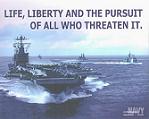pvebber, don't no why I didn't think of it earlier but for training/teaching purposes click on the link below for FM3-24.2 Tactics in COIN. Go to Fig. 1-2 for an example ASCOPE model..... you will like itthen go to Fig. 6.2 to see an example of CARVER-P this is how to use it defensively but it can and should be used offensively, that is why it was originally created.
Hope this clears things up. Anymore questions or concerns just ask away.
http://usacac.army.mil/CAC2/coin/repository/fm3242.pdf






 the future, but nobody ever brings that up.
the future, but nobody ever brings that up.  . 5 Rings-like frameworks are importatn to understanding the problem, but the information you need to make them actionable is tremendous, fleeting and subject to contamination by an a sophisticated adversary.
. 5 Rings-like frameworks are importatn to understanding the problem, but the information you need to make them actionable is tremendous, fleeting and subject to contamination by an a sophisticated adversary. )
)

Bookmarks